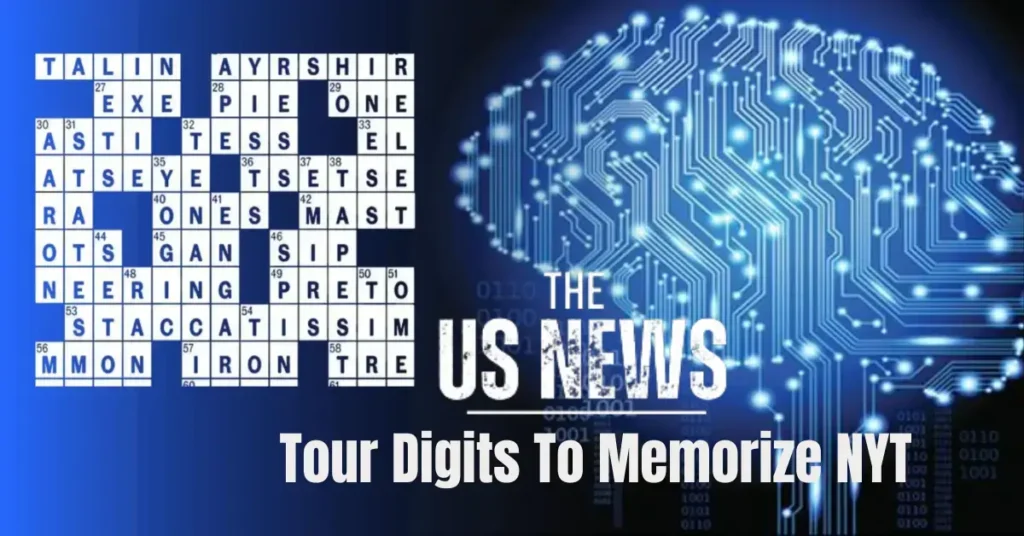In an era of saturating information and information, The New York Times (NYT) has launched a bold plan to engage its readers with a singular approach. The obscure phrase four digits to memorize nyt has created interest among puzzle lovers as well as casual readers. This article tries to unravel the mystery of this fascinating statement, examining the cognitive challenges it poses and the potential implications for memory and problem-solving skills.
The Intriguing Phrase
The seemingly straightforward combination of using words four digits to memorize nyt has significance because of the mental challenge it creates. The New York Times, known as a reliable resource for information has gone beyond the norm of journalism to offer its readers an intellectual exercise that is beyond what is normal.

Cognitive Challenges within the Digital Age
The age of digital has led to a shift in the way we process and process information and information, with attention spans shrinking as multitasking is becoming the standard. The idea of introducing an exercise that tests your brain like four digits to memorize nyt might be a wise move to motivate readers to take a break from their digital whirlwind and engage in more deliberate and focused tasks.
The Power of Four Digits
Why are there four numbers? The decision to use four digits requires a balance between difficulty and accessibility. It’s sufficiently long to require attention and recall, yet small enough to be an acceptable task for a wide audience. The use of numbers can add a dimension of complexity because numbers are typically more difficult to recall than words.
Memory And Its Mysteries
Memory is an intriguing aspect of human cognition and knowing how it functions can help us understand the efficacy of tasks such as four digits to memorize nyt. This test does not just assess our memory abilities but also helps to develop memory strategies that are personalized.
The Impact on Problem-Solving Skills
Participating in tasks that test cognitive capabilities has been associated with improved ability to solve problems. The four digits to memorize nyt problem is more than memorizing; it requires an enlightened approach and pattern recognition. Participants could develop new strategies for solving the challenge and increasing their analytical capabilities while doing it.
Cultivating The Skill
Like all skills mastering four digits is a skill that requires repetition and perseverance. Implementing memorization activities into routines, and gradually increasing the difficulty of the sequences, will improve memory and help develop the ability to go beyond basic digit recall.
The Cognitive Benefits
The benefits of mastering this art of four digits to memorize nyt aren’t limited to immediate applications. Research has shown that constantly testing our memory can improve long-term health and cognitive well-being. When we traverse the world of technology and interact with the world around us, we should not forget the importance of fostering the cognitive capacities necessary to be quick and flexible minds.
The Social Aspect of the Challenge
Beyond personal participation Beyond individual involvement, the four digits to memorize nyt challenge has created an esprit de corps among the participants. Forums on the internet, social media platforms as well as dedicated groups have sprung up in which people can share their experiences as well as their insights and, sometimes frustrated with the task. The communal aspect gives a social aspect to the cognitive challenge creating a sense the connection between participants.
The Role of Puzzles in Cognitive Health
Activities that require a lot of thinking are long-standing a part of mental health. The NYT’s announcement of this challenge is in line with the growing recognition that it is vital to maintain mental health in the face of contemporary issues.

Potential Educational Applications
The four digits to memorize nyt challenge can open up new opportunities for education programs. Teachers and educators can get ideas from similar challenges that encourage cognitive development among students. Implementing such activities in learning environments can foster imagination, critical thinking, and a comprehension of the subject that are being investigated.
Conclusion
The four digits to memorize nyt challenge is not just a simple string of words. It’s an opportunity to challenge our minds in a society that is often awash with data. When we are trying to navigate the complexity of our digital world brain-training challenges such as this are a refreshing and stimulating opportunity to sharpen our cognitive capabilities. In terms of unlocking the code overcoming an obstacle to learning or feeling the feeling of community that comes from sharing experiences, This NYT initiative has left an impression on all those who tackle the task. Therefore, the next time you see the four digits think of them as a challenge take them as a chance to discover the depths of your mental abilities.
What is the significance of four digits to memorize NYT?
Four digits to memorize NYT is a mysterious phrase that was introduced by New York Times (NYT) as a mental challenge. It requires you to memorize a particular four-digit sequence and has created interest among readers.
Why did the New York Times create this challenge?
The NYT launched this contest as a novel way to attract readers and give them a unique intellectual challenge. The challenge encourages participants to break out of the digital noise and increase their mental abilities.
What is the cognitive task involved in memorizing four digits?
Recalling the four-digit sequence challenges participants to improve their memory skills, and also encourages the ability to think critically and recognize patterns. It goes beyond mere memorization and requires a thoughtful method of finding the answer.
Why specifically four digits?
The selection of four numbers strikes a delicate balance between complexity and accessibility. It’s sufficient to draw attention and memory, but it is also small enough to be an achievable test for a wide audience.
How does the challenge impact memory and problem-solving skills?
Participating in the four numbers to memorize NYT challenge is not just about assessing memory abilities but also improves the ability to solve problems. Participants will develop ways to solve the problem, while also improving their abilities to analyze while doing it.
How can one cultivate the skill of memorizing four digits?
As with any other ability, learning to memorize four digits requires consistency and practice. Incorporating memorization into routines, and gradually increasing the difficulty of the sequences improves memory and improve cognitive abilities.
Are there cognitive benefits associated with mastering this challenge
Absolutely, conquering the four numbers to remember NYT challenge could contribute to longevity and health for your cognitive. A regular challenge to memory can have positive effects on the retention of memory as well as attention span and general mental health.
The contest has sparked an esprit de corps among the participants. Social media forums, online forums platforms, and dedicated groups have sprung up in which people can share their stories or insights and occasionally frustrated with the challenges.
How does the challenge align with the importance of cognitive health?
Puzzles and cognitive problems such as four digits to learn NYT coincide with the growing recognition of the necessity of maintaining your cognitive health to meet new challenges in technological advancements.
Are there potential educational applications for this challenge?
The challenge can be used to create educational programs. Teachers and educators can create similar challenges that encourage cognitive development among students encouraging the ability to think critically, develop creativity, as well as a deeper understanding of the subject.
What is the lasting impression of the four digits to memorize NYT challenge?
The game isn’t just a straightforward game; it’s an opportunity to discover the depths of your cognitive abilities. The participants often feel a sense of satisfaction finding the solution, getting over cognitive obstacles, and gaining an underlying sense of belonging by sharing experiences.





